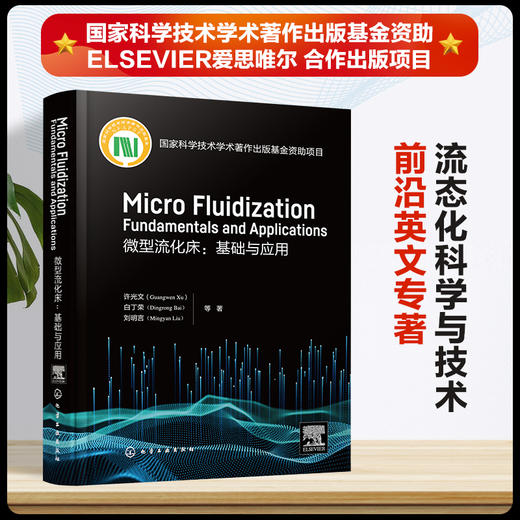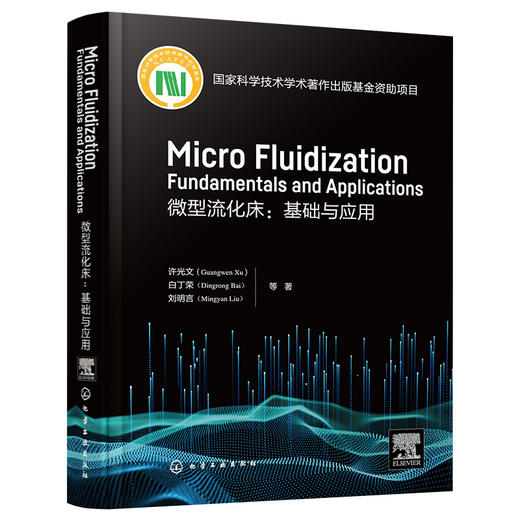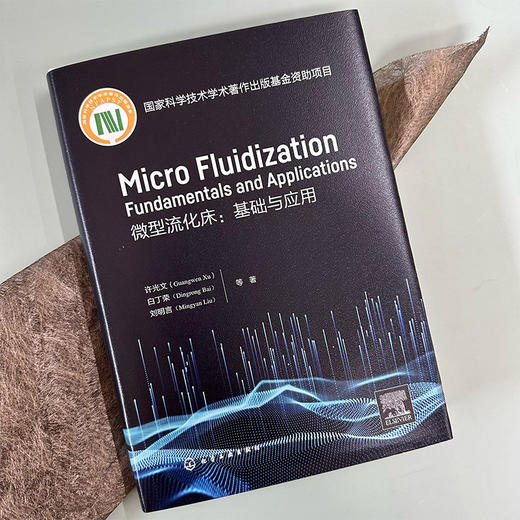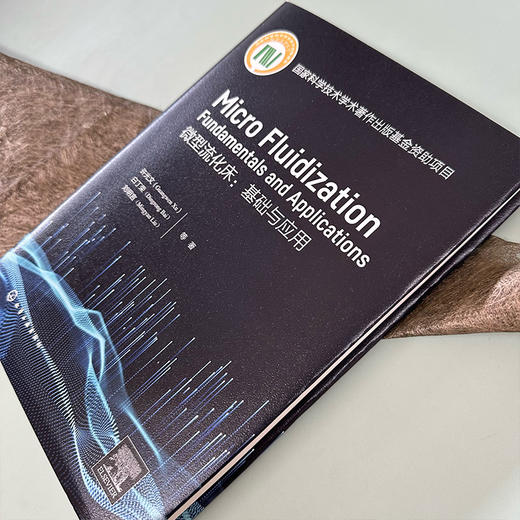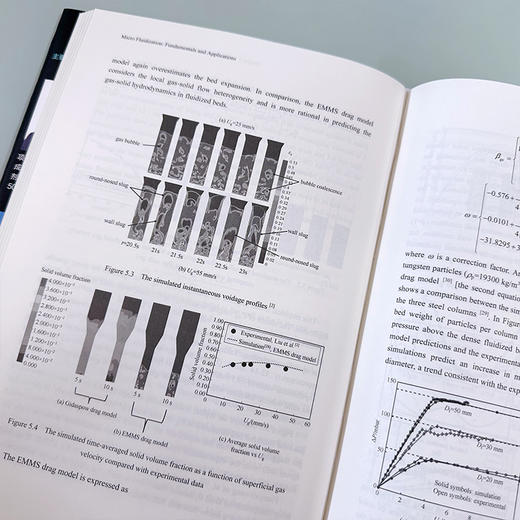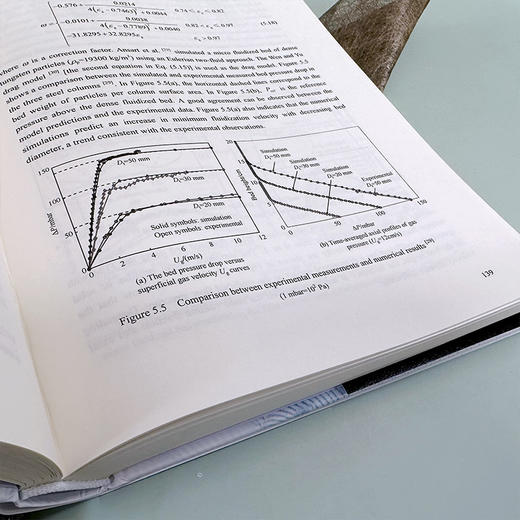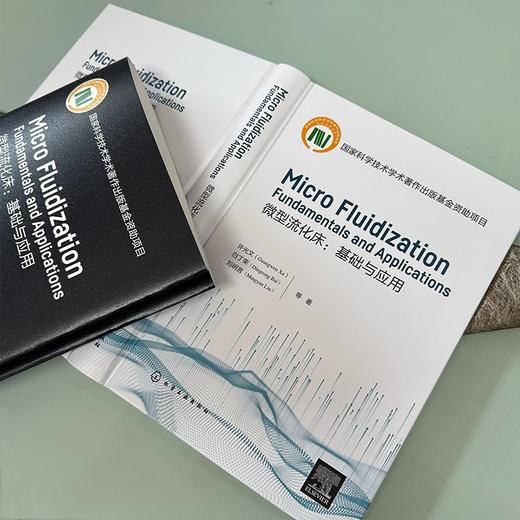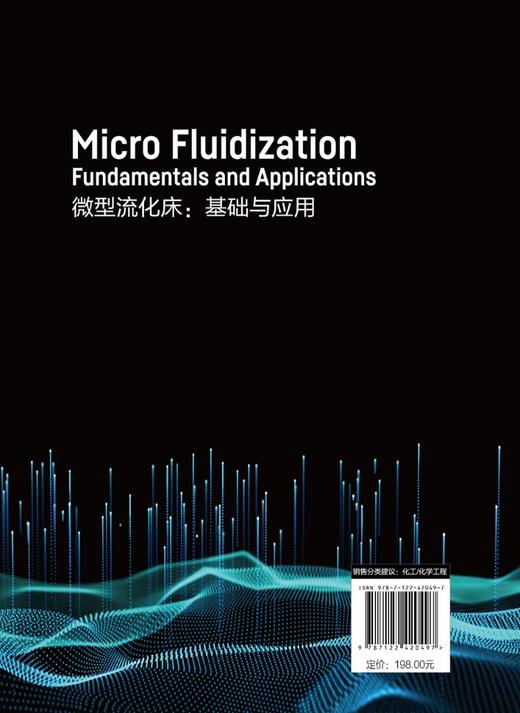Micro fluidization: Fundamentals and Applications (微型流化床:基础与应用)
| 运费: | ¥ 0.00-20.00 |
商品详情
书名:Micro fluidization: Fundamentals and Applications (微型流化床:基础与应用)
定价:198.0
ISBN:9787122420497
作者:许光文(Guangwen Xu)、白丁荣(Dingrong Bai)、刘明言(Mingyan Liu) 等 著
版次:第1版
出版时间:2023-01 
内容提要:
本专著内容涵盖微型流态化科学和技术研究的背景历史和重要成果,总结微型流态化基本原理、流体力学特性、流态化典型流型及其转变、流体和颗粒混合、基于双流体及离散元模型的微型流化床数值模拟、工程热化学领域研究中常用的热分析微型反应器、微型流化床反应分析系统、微型流化床反应分析仪特征、微型流化床反应分析应用以及微型流化床反应器在工业技术开发中的前景等内容。专著也概括了液固两相和气液固三相微型流化床的发展、流体力学及传递特性、在化学及生物化工中的应用等内容。 本专著可供从事流态化和颗粒技术,尤其是对微型流化床基础研究及应用技术感兴趣的学生、研究人员、工程师或其他读者参考,同时也可作为化学工程专业的研究生教材或参考书。
目录:
Chapter 1 Introduction 001
1.1 Fluidization and fluidized bed 001
1.2 Typical ΔPB-Ug relationship 003
1.3 Geldart powder classification 006
1.4 Gas-solid fluidization regimes 007
1.5 Fluidization applications 010
1.6 Miniaturization of fluidized beds 013
1.7 Micro fluidized bed applications 017
1.8 Sources of information on micro fluidization 018
Abbreviation 019
Nomenclature 019
References 020
Chapter 2 Fundamentals of Gas-Solid Micro Fluidization 027
2.1 Bed pressure drops in micro fluidized beds 027
2.1.1 The bed pressure drop overshoot 028
2.1.2 The bed pressure drop offset 030
2.1.3 Deviation from the Ergun equation 033
2.2 Mechanistic analysis of the wall effects 036
2.2.1 The wall frictional force 038
2.2.2 Increase in bed voidage 043
2.2.3 Inhomogeneous flow 045
2.3 Discussions on the wall effects 050
2.4 Other influencing factors 053
2.4.1 Influence of particle diameter 053
2.4.2 Influence of gas properties 055
2.4.3 Influence of temperature 056
Abbreviation 057
Nomenclature 057
References 059
Chapter 3 Gas and Solid Mixing 062
3.1 Experimental and analytic techniques 062
3.1.1 Gas residence time distribution 063
3.1.2 Axial dispersion model 065
3.2 Gas mixing 069
3.2.1 Gas residence time distribution 069
3.2.2 Axial gas dispersion coefficient 071
3.2.3 Two-phase model analysis 072
3.2.4 The criteria for plug flow of gas in micro fluidized beds 077
3.3 Solid mixing 081
3.3.1 Solid mixing simulation 081
3.3.2 Particle feeding simulation 082
Abbreviation 086
Nomenclature 086
References 088
Chapter 4 Micro Fluidization Regimes 090
4.1 Experimental observations 090
4.2 Fixed bed 092
4.3 Minimum fluidization velocity 096
4.3.1 Factors influencing Umf 096
4.3.2 Prediction of minimum fluidization velocity 099
4.4 Particulate fluidization 102
4.5 Bubbling fluidized bed 104
4.5.1 The onset of bubbling fluidization 104
4.5.2 Prediction of minimum bubbling velocity 107
4.5.3 Bubble size 108
4.6 Slugging fluidized bed 109
4.6.1 The onset of slugging fluidization 109
4.6.2 Prediction of slugging velocity 111
4.7 Turbulent fluidized bed 113
4.7.1 The onset of turbulent fluidization 113
4.7.2 Prediction of transition velocity Uc 115
4.8 Distinction between micro and macro fluidized beds 116
4.9 Fluidization regime map for micro fluidized beds 119
Nomenclature 125
References 127
Chapter 5 Hydrodynamic Modeling of Micro Fluidized Beds 129
5.1 CFD modeling approaches 129
5.2 Two-fluid method 132
5.2.1 TFM formulation 132
5.2.2 TFM simulations and validations 136
5.2.3 TFM-predicted MFB hydrodynamics 140
5.3 The discrete element method 144
5.3.1 Model formulation 145
5.3.2 DEM simulations and validations 146
5.3.3 DEM-predicted MFB hydrodynamics 147
5.4 A brief discussion and future perspective 152
Abbreviation 153
Nomenclature 153
References 154
Chapter 6 Microreactors for Thermal Analysis of Gas-Solid Thermochemical Reactions 158
6.1 Thermal analysis approaches 158
6.1.1 Thermochemical reaction pathways 158
6.1.2 General requirements for thermal analysis approaches 159
6.2 Microreactors for thermal analysis 163
6.2.1 General approaches and requirements 163
6.2.2 Classification of microreactors 163
6.3 Furnace heating micro reactors 166
6.3.1 Micro fixed bed reactor 166
6.3.2 Gas pulsed microreactor 167
6.3.3 Thermogravimetric analyzer 168
6.3.4 The single and tandem ?-reactors 170
6.3.5 Drop-tube reactor 172
6.3.6 Catalyst cell fluidized bed reactor 173
6.4 Resistively heated micro reactors 174
6.4.1 Wire mesh reactor 174
6.4.2 Curie point reactor 176
6.4.3 Pulse-heated analysis of solid reaction reactor 177
6.4.4 Microprobe reactor 178
6.5 Particle bed heating micro reactors 178
6.5.1 Micro spouted bed reactor 178
6.5.2 Micro fluidized bed reactor 179
6.6 Other non-resistively heating micro reactors 180
6.6.1 Microwave microreactor 180
6.6.2 Laser ablation reactor 180
6.6.3 Thermal plasma reactor 181
6.7 Remarks 182
Abbreviation 184
References 184
Chapter 7 System of Micro Fluidized Bed Reaction Analysis 188
7.1 System configurations 189
7.1.1 System configurations of micro fluidized bed reaction analyzer 189
7.1.2 Micro fluidized bed reactor design 192
7.1.3 Solid sample feeding method 194
7.1.4 Liquid sample feeding method 195
7.1.5 Online gas sampling and analysis 196
7.1.6 Online particle sampling 197
7.1.7 Change of reaction atmosphere 198
7.2 Kinetic data analysis 200
7.2.1 Data acquisition 200
7.2.2 Data processing 201
7.2.3 Kinetic modeling 202
7.3 New developments in MFBRA 203
7.3.1 MFB thermogravimetric analyzer 203
7.3.2 Induction heating MFB 205
7.3.3 External force assistance 206
7.3.4 Micro spouted bed reaction analyzer 208
7.3.5 Membrane-assisted micro fluidized beds 208
7.3.6 Other developments 209
Abbreviation 209
Nomenclature 210
References 211
Chapter 8 Characteristics of Micro Fluidized Bed Reaction Analyzers 215
8.1 Approaching intrinsic kinetics 215
8.1.1 High heating and cooling rates 216
8.1.2 Effective suppression of diffusion 217
8.1.3 Close-to-plug flow of gas 220
8.1.4 Bed homogeneity 222
8.1.5 Applied kinetics 222
8.2 Understanding reaction mechanism 226
8.2.1 Revealing the true character of fast reactions 226
8.2.2 Detecting intermediary reactions 228
8.2.3 Decoding the reaction mechanism 229
8.2.4 Reactions with in/ex-situ solid particles 230
8.2.5 Non-isothermal differential applications 232
8.3 Reactions under water vapor atmosphere 233
8.3.1 High moisture content feedstocks 233
8.3.2 Reactions with steam as reactants 234
8.4 Sampling and characterization of solid particles during a reaction process 235
8.5 Multistage gas-solid reaction processes 236
8.6 Reaction kinetics under product gas inhibitory atmospheres 238
8.6.1 Isotope tagging method 238
8.6.2 Comparisons between the micro fluidized bed and thermogravimeter 239
Abbreviation 240
Nomenclature 241
References 241
Chapter 9 Applications of Micro Fluidized Beds 244
9.1 Drying 244
9.2 Adsorption 245
9.2.1 CO2 capture using capsulated liquid sorbents 246
9.2.2 CO2 capture using solid adsorbents 247
9.2.3 CO2 capture by gas-solid reactions 247
9.3 Catalytic reaction 249
9.3.1 Catalytic gas reaction 249
9.3.2 Catalytic gas-solid reaction 250
9.4 Thermal decomposition 255
9.4.1 Liquid decomposition 255
9.4.2 Solid decomposition 256
9.5 Pyrolysis 257
9.5.1 Biomass pyrolysis 258
9.5.2 Coal and oil shale pyrolysis 259
9.5.3 Blended material pyrolysis 259
9.6 Thermal cracking 262
9.7 Gasification 264
9.7.1 Biomass gasification 264
9.7.2 Coal gasification 265
9.7.3 In/ex-situ char gasification 265
9.8 Combustion 267
9.8.1 Decoupling combustion 267
9.8.2 Oxy-fuel combustion 268
9.8.3 Chemical looping combustion 269
9.8.4 In/ex-situ chart combustion 270
9.9 Reduction 272
9.9.1 Iron ore reduction 272
9.9.2 Nitrogen oxide reduction by tar 273
9.9.3 WO3 reduction-sulfurization 273
9.10 Other reactions 274
References 274
Chapter 10 Applications of MFBR in Industrial Process Development 281
10.1 Advanced combustion with low-NOx emissions 281
10.1.1 Low-NOx combustion technology 281
10.1.2 NOx reduction by pyrolysis products 283
10.1.3 Pilot experiments and commercial application 287
10.2 Reaction characteristics tested by MFBRA for biomass staged gasification 290
10.2.1 Staged gasification process analysis using MFBRA 290
10.2.2 Characteristics of gasification sub-processes by MFBRA 291
10.2.3 Design of an industrial FBTS gasification process 299
10.3 Light calcination of magnesite using transported bed 301
10.3.1 Existing technology and equipment 302
10.3.2 Kinetic analysis of magnesite calcination 302
10.3.3 Advanced transport bed calcination process 304
10.3.4 Engineering commissioning of a 400 kt/a industrial process 306
Abbreviation 307
Nomenclature 308
References 308
Chapter 11 Characterization of Liquid-Solid Micro Fluidized Beds 311
11.1 Introduction 311
11.2 Hydrodynamics properties 312
11.2.1 Manufacturing methods 312
11.2.2 Minimum fluidization velocity 313
11.2.3 Mixing 318
11.2.4 Mass transfer 319
11.3 Applications 322
11.3.1 Chemical conversions 322
11.3.2 Bioprocessing and bioproduction 322
11.3.3 Other applications 329
11.3.4 Challenges and prospects for MFB scaling-up 329
11.4 Conclusion 330
Abbreviation 330
Nomenclature 331
References 331
Chapter 12 Characterization of Gas-Liquid-Solid Micro Fluidized Beds 338
12.1 Hydrodynamics 338
12.1.1 Pressure drop and minimum fluidization velocity 338
12.1.2 Flow regimes, expanded behavior, solid holdup, and multi-bubble behavior 349
12.2 Applications 366
12.2.1 Chemical reactions 366
12.2.2 Photocatalytic degradation of methylene blue (MB) 367
12.2.3 Catalytic oxidation of crotonaldehyde to crotonic acid 372
12.3 Summary 375
Nomenclature 375
References 377
Future Prospects 378
- 化学工业出版社官方旗舰店 (微信公众号认证)
- 扫描二维码,访问我们的微信店铺
- 随时随地的购物、客服咨询、查询订单和物流...
